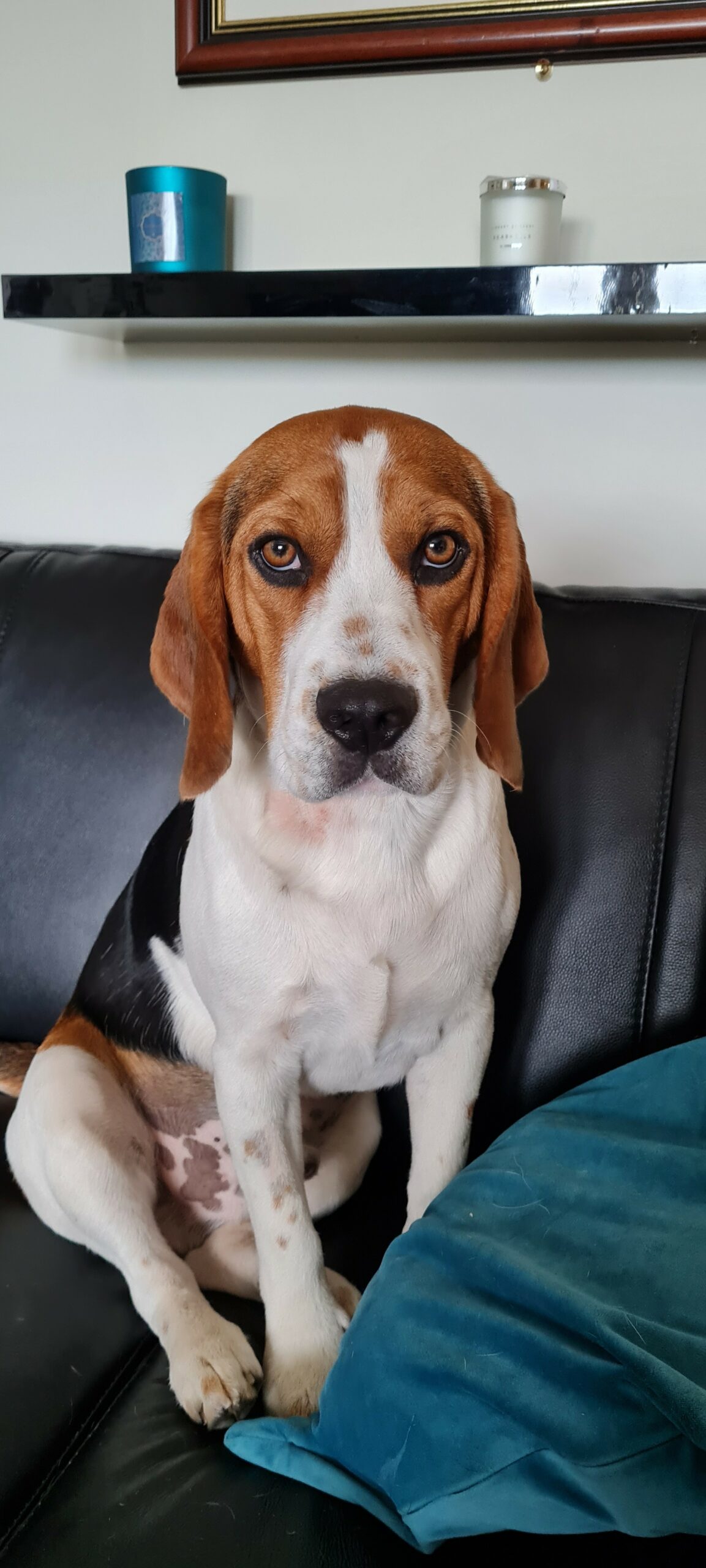Surgical Mystery with a Happy Ending
Unveiling the Mysteries of Cryptorchidism
Published on: Apr 10, 2024
Neutering pets is a day-to-day procedure for vets and the frequency with which it is performed means that it tends to be viewed as a routine surgery most of the time. However, sometimes we see the odd patient for neutering that makes it just that little more unusual. Gus was certainly one of those patients!
Gus is a 1 ½ year old Beagle with a lovely nature. When he first came to see us he was very healthy in every way, but there was one little concern – he only had one testicle, a condition known as cryptorchidism. This is something that happens on occasion, as a testicle can fail to descend from its initial position within the abdomen into its usual position in the scrotum. It is usually not a cause for concern in a puppy, and the undescended testicle will often appear as the body develops, but if it doesn’t there are long term implications. The reason for this is that a testicle that is retained within the body, either higher in the groin or within the abdomen, is at a higher temperature than normal and over time (months to years) this can lead to cancerous changes that can be life threatening in numerous ways. However, the good news is that if we perform surgery to locate and remove the undescended testicle, before these changes develop, then we can eliminate these long term health risks. This is just slightly more complicated than a normal castration but is still usually a fairly routine procedure.
Gus’s owner was keen to prevent any future health issues. As such Gus was scheduled for his castration surgery to locate and remove his testicles – including the one that was hiding! Given that we strongly suspected the hidden testicle was still within the abdomen – we couldn’t feel it anywhere within his groin – our standard approach would be to use the laparoscope (keyhole camera) to explore his abdomen, identify the testicle and then make a small incision to allow us to remove it in the most minimally invasive way possible.
Gus was very well in every other way and so was in a playful mood when he visited for his procedure. He underwent his anaesthetic and then we started the procedure as planned by using the laparoscope to locate his testicle. However, this proved to be more of a puzzle than we expected. As we searched his abdomen, we could clearly see from the structures present (and not present) that his testicle had not descended as normal towards his scrotum, and therefore wouldn’t be hiding on its way out or high in the groin. However, despite searching and searching we simply could not find his elusive testicle anywhere. Eventually we had to admit defeat. We performed a routine castration for his normal testicle and closed the 5mm incision in his abdomen through which the camera had been used.
We honestly all felt a little demoralised at that point. While we do routinely see cryptorchid patients, and have to search for the hidden testicle, it is extremely rare for a dog to actually only have one testicle. We were concerned that Gus still had a hidden testicle, perhaps small or underdeveloped, that we had simply not managed to identify. However, we decided that a little bit of time may give us the answer and we created a plan to find out once and for all what had happened.
After getting advice from our external laboratory, and knowing we had now removed the other testicle, the plan was to run a blood test for a particular hormone produced by testicular tissue. If still present in the blood stream a few weeks after the normal testicle had been removed then this would indicate that he still had a functional testicle hiding and so we would need to try again to find it. If the hormone was low then this would suggest that there was no remaining testicle and that Gus was just a very unusual one-balled dog!
Gus recovered well and seemed remarkably spritely after his op. The laparoscope is minimally invasive and so his day of abdominal searching hadn’t fazed him too much. Several weeks later he was back for his blood test and everyone was keen to know the result. Was there still a hidden testicle? Would Gus have to undergo more tests? Was he, quite literally, an odd-ball?
Within a few days we had our answer and the sample confirmed that Gus had no functional testicular tissue. In short, one of his testicles must have simply never developed. This result meant that we could stop agonizing over whether we had missed it at surgery and Gus’s owner could relax knowing that no further treatment was needed. We all felt a strange mix of fascination and relief, and I’m sure if we could have explained the situation to Gus that he would have felt the same.


Author –
Martin Law
Neutering mystery! Read the intriguing case of Gus, a Beagle with one descended testicle (cryptorchidism). Discover how Shepton Vets used laparoscopy & blood tests to solve it.
#CryptorchidismInDogs #LaparoscopicSurgery #UndescendedTesticle #MinimallyInvasiveSurgery #BloodTestForTesticularFunction #OneBalledDog #UniquePets #SheptonVets #VeterinaryExpertise #ExceptionalPetCare
Read more from Martin
Related Article
Caring for your pet as we do our own

At Shepton and Wells Vets, we understand what your pets mean to you, and so our Pets team aim to care for each and every one of them as we would do our own.
We care about your pet
Our primary focus is keeping them fit, happy and healthy with comprehensive and effective preventative healthcare, advice and treatment.
We care about you
We aim to communicate clearly and honestly with you, and discuss different treatment options so that you can make the right informed choices for you and your pet.
We care about clinical excellence
We take pride in providing a high level of medical and surgical care, working together as a team to do the very best we can for your pet.











